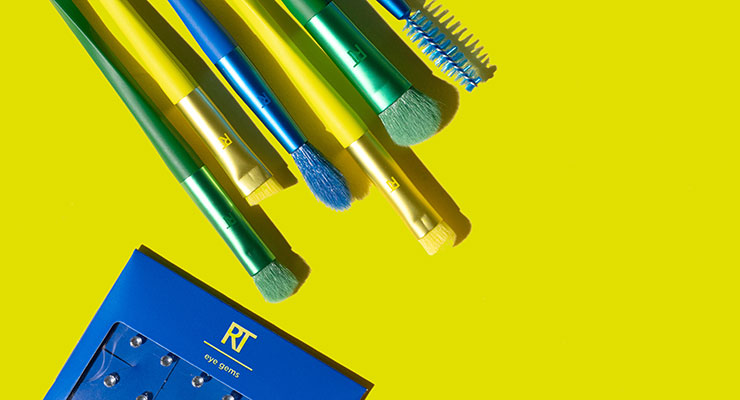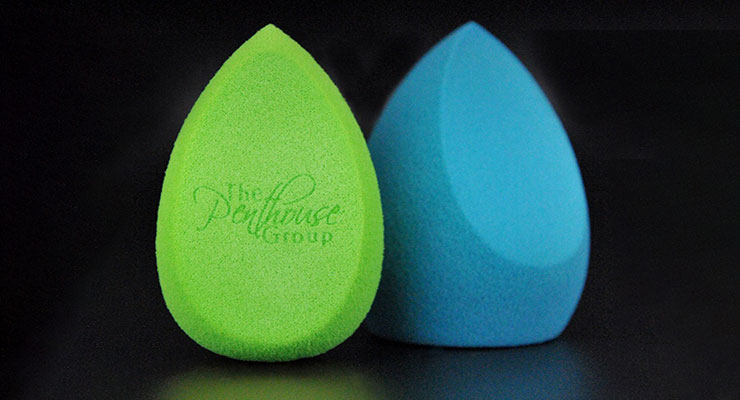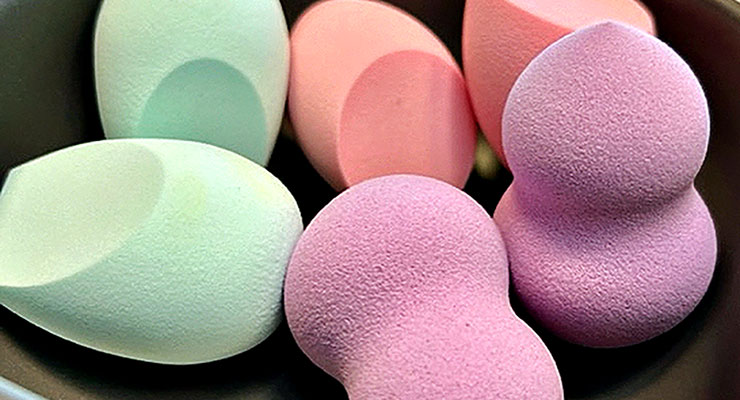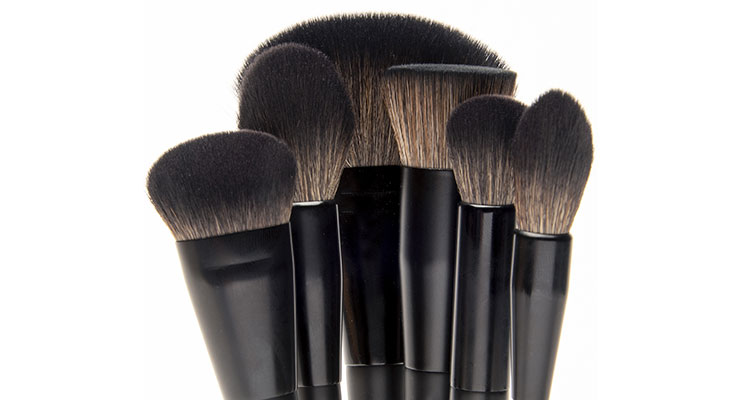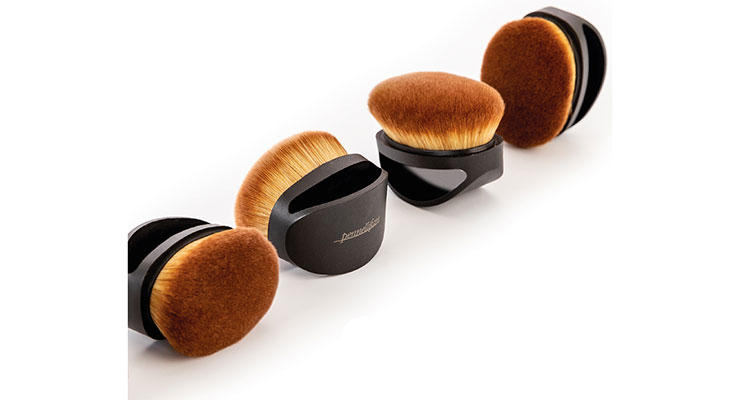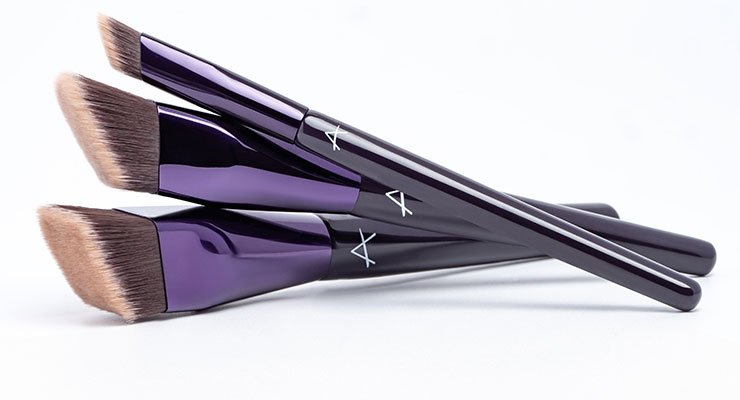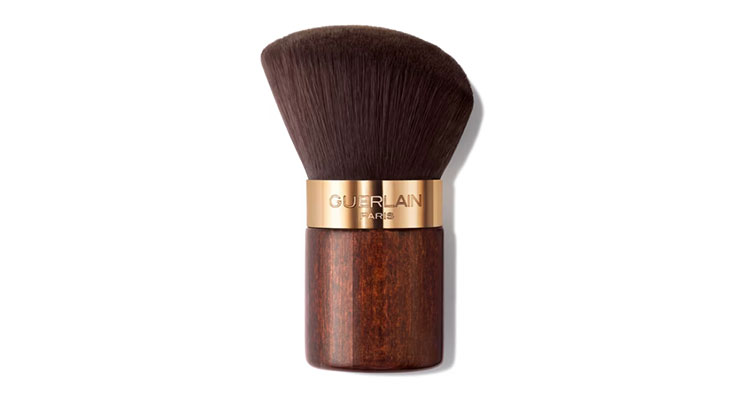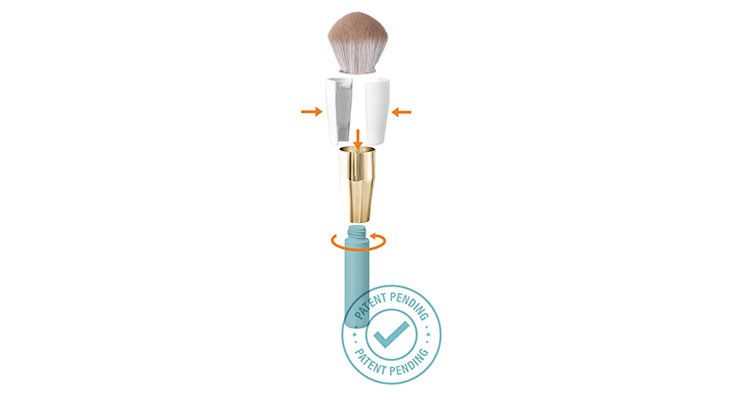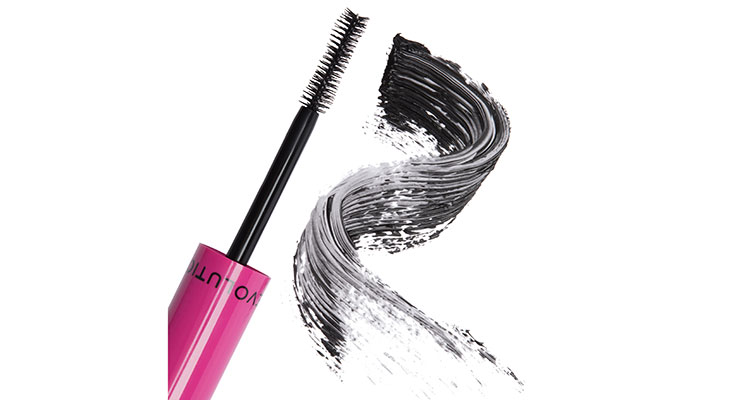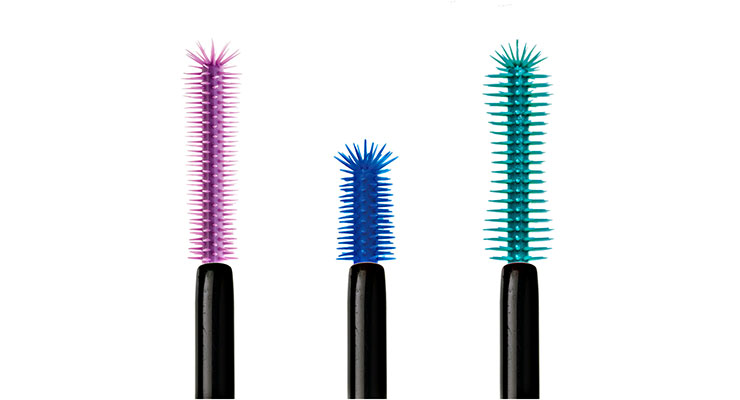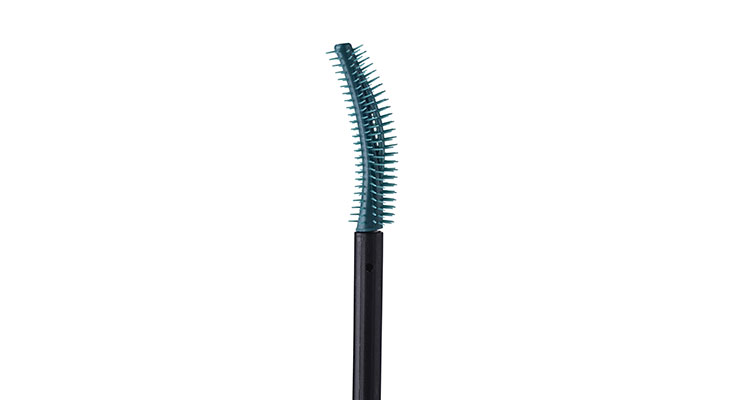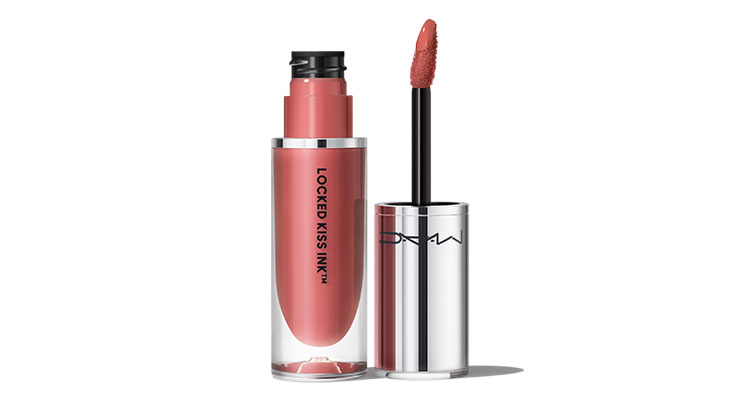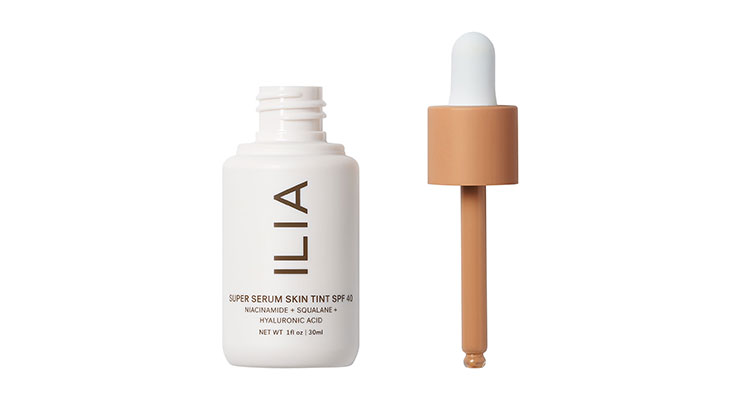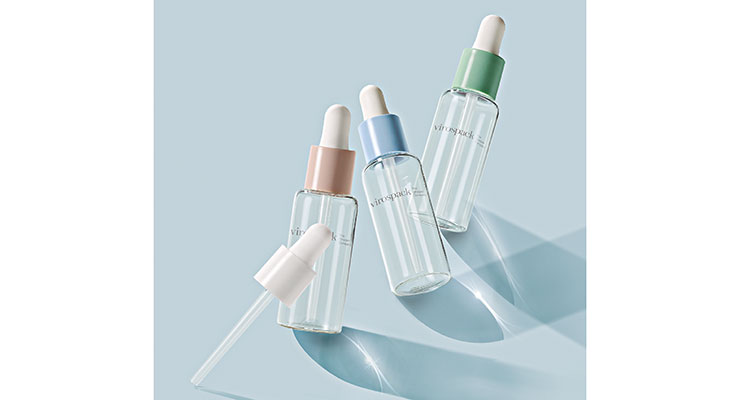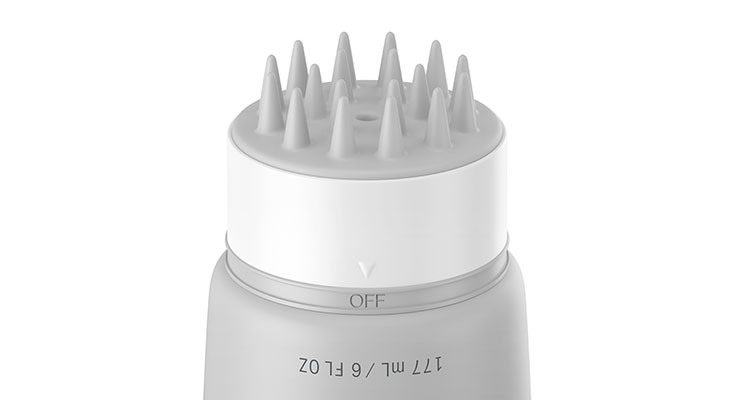Marie Redding, Senior Editor04.26.23
Beauty consumers love their makeup brushes—and this is evident in the popularity of how-to videos that are often trending. “Interest in applicators is at an all-time high. Beauty consumers have become ‘makeup pros’ due to social media—and are experts in using applicators and brushes,” says Steven Ostrower, president, The Penthouse Group.
Consumers are taking more time for self-care—and may be more willing to try new types of applicators and brushes. “Trying a new self-care beauty tool is enjoyable, and beauty consumers are spending more time on beauty rituals,” says Anisa Telwar Kaicker, founder & CEO of Anisa International. “Along with an increasing number of requests from our b2b business, we see sales of our skincare brushes and tools rising within our d2c brand, Anisa Beauty,” she says.
Reports confirm that the demand for makeup brushes is rising. The global market for makeup brushes was estimated to be worth $1.8 billion in 2021, and is expected to rise to $2.6 billion by 2028. MarketWatch says to expect a CAGR of 5.2% during the forecast period.
Elevating the Application Experience
It’s easy to see why brushes and applicators are so popular. Squeezing a tube, pumping a bottle, or swiping a stick product across your skin can’t compare to an applicator’s precision. Pairing a product with the best type of brush, sponge, or wand applicator for the formula will elevate the application experience and deliver the best results—especially for mascara.“Achieving the best mix between applicator, wiper, and formula is our area of expertise at the HCP-SIMP Lash Studio. We push technical boundaries to innovate continuously,” says Stephanie Rowntree, global product manager of HCP Packaging.
Since it’s crucial that an applicator is compatible with a formula, clean products made with natural ingredients can present a unique set of challenges. Synthetic fibers for vegan brushes are also increasingly important, while brushes and applicators made from eco-friendly materials can help advance a brand’s sustainability goals.
“Every beauty brand wants to be more sustainable and eco-friendly in their manufacturing processes. We developed brushes made with recycled fibers, and we use FSC-certified wood or recycled plastic for handles,” says Rowntree.
Beauty brands also want more design options, suppliers say. “Cosmetic applicators are evolving along many different paths,” says Sara Zanafredi, CEO of Pennelli Faro. “Brands are increasingly asking for customization,” she says. The supplier’s new Bold Identity color palette offers brushes with handles in six color options, with shiny or matte finishes.
Read on for more about how packaging suppliers balance current trends while developing high-performing applicators for all types of products.
Material Innovations—Vegan & Eco-Friendly are Key
We spoke to suppliers about material innovations for brushes and sponges, and there are two prevalent trends—vegan and eco-friendly. “Vegan and cruelty-free are definitely ‘non-negotiable’ when developing an applicator today,” says Ostrower, of The Penthouse Group.Material innovations for brushes and applicators have advanced so much in recent years that many suppliers can easily meet a brand’s requirements for vegan and cruelty-free options.
The Penthouse Group has a 71-year history of producing innovative puffs and sponges. “Clean beauty and sustainable materials are critical trends, and for applicators, there’s a strong pull toward sustainability,” says Ostrower. “Our policy is to drive the use of sustainable materials with every new product we develop.”
Ostrower says new designs are based on new material innovations. “Raw material options have changed drastically over the past year and continue to advance,” he says. Bio-resins and certified fair-trade natural rubber for sponges are a few of the supplier’s latest offerings. The Penthouse Group offers velour derived from recycled PET, certified organic cotton velour, and 100% recycled polyester ribbons for puffs.
The Penthouse Group often works with brands to develop multi-faceted blending sponges in new shapes so that users can easily contour, blend, blur, and conceal. “We also offer custom colors, marbleizing, laser logos, additives, flocking, gradient deco, and color-changing designs,” he says.
Siti Khalid, executive director of product development, Taiki, agrees that “sustainable vegan” is a trend—and says it’s here to stay. “Over the past few years, consumers have shifted their focus toward sustainable and eco-friendly products. Consumers are searching to support brands that are cruelty-free, ethically sourced, and better for the planet,” Khalid says.
Taiki offers sponges made with up to 40% plant-based materials. The supplier’s bio-based sponges are 100% biodegradable. Taiki also offers makeup brush handles made with various sustainable materials, including FSC wood, upcycled materials, biodegradable PLA and bamboo. “We also offer vegan fibers, vegan glue, and mono-material brushes for easy recycling,” Khalid says.
Beauty brands risk negative pushback from consumers if makeup brushes aren’t cruelty-free. But natural hair versus synthetic was once debated among brush manufacturers because performance was an issue. Now, a lot has changed.
Garrett Hewitt is one supplier that stayed a step ahead of the move toward “cruelty-free” by setting up synthetic fiber manufacturing inside its brush-making facility more than 10 years ago.
“We saw this as an opportunity to not only eliminate the dependence of an outside supplier, but it also allowed us to lower costs and, most importantly, develop new fiber technologies that closely replicate the look, feel, and performance of natural fibers,” says Jason Clerke, president of Garrett Hewitt.
Ensuring that synthetic fibers have the look, feel and performance of natural hair is still challenging, but Clerke says they have made extreme advances in perfecting the technology. “Our fiber range, some of which are patented, includes our exclusive trademarked EvoFibers,” he says.
Synthetic fibers allow for a level of manipulation that can’t be achieved with natural hair. The team at Garrett Hewitt custom engineers the fiber diameter, tensile strength, and taper of the fiber’s tip. “We can also control how straight or wavy the fiber is and its surface texture,” says Clerke. “Combining different fibers within the same brush ensures a perfect application, customized to the product,” he says.
Brushes Inspired by Makeup Trends
Often, the makeup look a brand wants the user to achieve dictates a brush design. Real Techniques’ new “Daygleam So Jelly Eye Set” includes six bright blue, green and yellow brushes. The brushes easily apply ultra-pigmented eyeshadow or glossy formulas for a “jelly makeup” look.The brush heads have soft, densely packed fibers to pick up and deposit a maximum amount of product. “The bristles are soft, vegan, synthetic hair for streak-free, seamless blending,” says Alex Larson, brand manager at PPI Beauty, Real Techniques’ parent company.
Unlike traditional round handles, the Daygleam brush handles have a twisted shape with a flat surface to rest your finger on, and grip the brush securely. “The brushes have elongated, tapered handles to give users maximum control and balance when applying makeup. We worked with our suppliers to create a unique beveled shape that allows users to hold the brush in a way that feels natural,” explains Larson.
Real Techniques was one of the first brush brands on the market to help beauty consumers apply “makeup like a pro” with its affordable sets and how-to videos.
Designed for Flexibility & Precision
Pairing a product perfectly with the right style brush is Pennelli Faro's expertise. The supplier has an innovative design—the “Fless” brush. Available in two sizes, it features a short half-moon-shaped handle to grasp. It delivers the flexibility of a sponge combined with the precision of a brush.“We pursue unconventional innovation by designing ergonomic and wearable applicators. Fless redefines the rules of makeup applicators—it is the first flexible brush that naturally follows the face lines and fits intuitively in hand,” says Alessio Marani, sales manager of Pennelli Faro.
“Wearing” the Fless brush feels like a natural extension of your fingers. It is ideal for face products, including liquid and compact foundation makeup, making concealing and contouring easy. “The extreme flexibility of both the fibers and brush allows for a perfectly controlled gesture,” says Marani.
The Fless brush is eco-friendly since it requires minimal parts without metal components. The supplier says it weighs less, so users will avoid fatigue and loss of precision.
Wedges & Angles Are Popular Brush Shapes
Makeup brushes in wedge shapes with sharp angles are popular. Anisa International offers on-trend brush shapes in its Wedge Brush Collection. Inspired by the shape of a traditional makeup sponge, the Wedge Collection works best with cream and liquid makeup products.“Our wedge-shaped brush head design provides a seamless and precise application. It has a dramatically angled head shape designed to offer the versatile application of a traditional single-use sponge—but with a sustainable and elevated experience,” explains Telwar Kaicker.
The brush’s densely packed fibers combine with a uniquely flexible tip that presses product into the skin and creates buildable coverage. “The sharp edges of the brush make it perfect for precise contouring and highlighting, which works well with today’s complexion makeup trends,” says Telwar Kaicker.
Anisa International also offers its new A-Line Brush Collection, ideal for pairing with multifunctional makeup stick formulas. It has a one-piece handle and a flat base to stand on a counter.
The supplier’s Dome Face Collection features a brush head designed for a sponge-like bouncing motion, not buffing. The Dome Face brushes will apply dewy foundation products with thick viscosities seamlessly and flawlessly.
Raphael has designed two ergonomic brushes that facilitate makeup application—the D-Brush and HD Brush. Raphael’s D-Brush is a dual-purpose brush with a rounded side and an edge for smaller details, so the user won’t have to switch brushes, according to Raphael.
The HD Brush is a square makeup brush with a geometric design with multiple benefits. According to Raphael, the angles allow for a precise application in areas of the face that are difficult to reach, where conventional brushes have the greatest difficulty applying product evenly. The edges allow the face to be sculpted with precision, and the large flat top facilitates blending.
Raphael worked with Guerlain to produce a high-density Kabuki brush and a beveled Kabuki Terracotta Brush. The Kabuki Terracotta Brush, shown, pairs with all Guerlain powders. It has soft bristles to deposit a veil of powder, and the short handle allows for a more controlled gesture, says Raphael.
A Recyclable Design for Brushes
Sustainability is always a consideration, and packaging supplier FS Korea has developed a sustainable innovation for brushes—its patented “Go Brush” set. The fibers, ferrule, and handle snap together instead of being glued. All parts are interchangeable and separate easily for recycling. Users can reuse the brush handle and ferrule with different brush heads.FS Korea says it developed its sustainable makeup brush concept after realizing that makeup brushes cannot be recycled if the parts can’t separate easily. “Preventing environmental pollution and climate change is so important—so we strive to develop products that reduce resource consumption, waste, and facilitate recycling,” says J.K. Hwang, CEO of FS Korea. According to Hwang, if all of the supplier’s customers used its Go Brush design, it would eliminate an estimated 130 tons of glue yearly.
EcoTools, another PPI Beauty brand, launched a brush set with interchangeable heads last year.
Advances in Mascara Brushes
There is no applicator more crucial to product application than a mascara brush. When a beauty brand finds that perfect combination of a formula that works well with a specific wiper and brush, it’s a winning combination for lashes.L’Oréal offers an astounding 31 mascara options on its website, each offering different benefits, such as “lift and length” or volume and length.” The company’s influencer strategy is on point. Its Telescopic Lift Mascara went viral with 348.4 million views and counting on TikTok, but there was some controversy, according to Grazia. Eva Longoria wore the mascara to the Oscars, and it was trending again.
L’Oréal Telescopic Lift Mascara has a unique double-hook bristle brush, and plenty of video reviews demonstrate the two-step application process printed on the packaging. The front hook lifts the lashes while applying, and the side-hook comb separates—for clump-free volume and length. The product claims to add up to 5 millimeters of length, while the ceramide-infused formula lasts up to 36 hours.
Makeup Revolution’s 5D Whip Lift Mascara claims to deliver “a salon lash lift effect in a bottle.” The brush is a twisted wire style, where fibers are wound around an inner wire core. The brand calls it its “vortex” brush and displays the name on the packaging. The brush is designed to grab every lash, lifting each up from the root for a lengthening effect. The ultra-black smudge-proof formula is vegan and contains castor oil and Argan oil.
Esme Morris, senior product manager at Revolution Beauty, says, “The vortex brush is a new technology in mascara brushes, which is incredibly exciting. The brush twists around like a DNA helix, so when brushing the product through your lashes, every hair is coated with the formula.”
The bristles’ wave shape further enhances product performance. “This mascara’s most exciting benefit is that every lash is lifted, creating gorgeous volume,” Morris says.
Morris explains the product development process: “The brush was the starting point—we loved how innovative it was and how well it worked. Next, we worked closely with our supplier to get the best pairing of an amazing, nourishing formula with the perfect wiper.” She continues, “The Italian supplier we work with is an expert in mascara and dedicated to ensuring each formula, brush, and wiper combination is the best it could be.”
Brivaplast, a supplier with a long history of mascara brush innovation, often works with brands to find the best match between the formula, brush, and wiper to deliver specific benefits. The company says its most often requested performance attributes for mascara are volume, lengthening and separation.
Brivaplast offers an extensive range of mascara brushes, including molded types in custom colors. Options include “Kernel Brow” and “Kernel Hourglass” brushes, which feature its patented kernel shape bristles.
Valentina Manera, marketing director of Brivaplast, explains, “Our patented kernel-shaped bristle section on our brushes helps to separate the lashes while gliding smoothly. The brush ensures an even product pick-up and smooth release due to its larger surface area when compared with a traditional cylindrical-shaped filament.”
When applying mascara, the bristles near the top of the brush achieve extra definition. “They are long enough to reach even the smallest lashes at the corner of the eye. They also add density to all lashes,” says Manera.
Mascara Gets ‘Clean’ & ‘Green’
Mascara brushes must ensure the product’s performance lives up to its claims—but in addition, beauty brands are looking for clean formulas and sustainable packaging. Packaging suppliers are navigating these new requirements and developing eco-friendly brushes and applicators that work well with clean formulas.HCP, with over 30 years of experience in applicator development and package design, says current product trends pose new challenges. “The clean, vegan formulas trending today are unique, with a viscosity and dynamic properties that require expert evaluation. These formulas have varying application properties, making it extremely important to customize the applicator and wiper system to achieve the targeted performance results,” explains Rowntree.
The team at the HCP-SIMP Lash Studio works with cosmetic formulators to identify a formula’s critical properties and then creates an optimized applicator solution. “We develop, design and create an optimized applicator for a formula to achieve homogeneous application to the lash,” explains Rowntree.
HCP also uses innovative eco-friendly materials. “Sustainability is not so much a trend, but a new standard,” says Rowntree. HCP offers fiber brushes made with castor oil bristles and molded applicators made with its exclusive fossil-free bio-based material, Eco-Flexi. “Exclusive to HCP, Eco-Flexi is a unique bio-based material that delivers sustainability with top-level performance,” says Rowntree.
HCP-SIMP’s Hyper Curve mascara brush, shown, has an ultra-curved shape that follows the eye’s contours. “Our patented single-arch design lifts all lashes in one stroke—providing instant volume, curl and lengthening results,” says Rowntree. HCP Group’s SIMP division also worked with L’Oréal to create a High Definition brush for Maybelline Sky High Mascara. “The bristles are placed around a conical body to build volume, length and definition for a high-precision application,” says Rowntree.
Chris Tarling, the founder of Mix Creative, says working with partners that are experts in sustainability, such as the US Plastics Pact, will help ensure that a material choice is the most sustainable option. “We believe all beauty brands can do better and be more sustainable,” he says.
Izzy Zero Waste Beauty partnered with MIX creative to produce its innovative sustainable mascara package. The brand collects back its packaging from consumers to recycle and reuse. “All the stems, wipers, and applicators are collected, washed, reground, and re-injected—so no waste is ever created,” says Tarling.
Tarling also says there is a rising demand for hybrid mascara brushes. Unlike twisted wire and molded brushes, hybrid brushes combine multiple manufacturing technologies. “When a brush has both molded and twisted wire parts, it delivers multiple benefits. We use our patented ZTIP technology to offer beauty brands a diverse range of brush options,” he says.
Applicators for Lip Color
Liquid lipstick and lip gloss require the right type of applicator that will pair well with the formula. Package designers and development teams think about the size, shape and material to create the best user experience.MAC’s new Locked Kiss Ink is a 24-hour weightless lip color containing passion fruit oil, coconut oil, and shea butter. The wand applicator is a slanted, tapered shape designed to help users apply the product flawlessly to deliver smooth, even color. “The pointed tip delivers unparalleled precision,” the brand states.
Lipstick—in a bullet—can also be applied with a traditional lip brush. It’s uncommon, but that may change. There is a renewed interest in lip brushes, according to Raphael. Applying lipstick with a brush results in a precise lip shape that can rival an MUA technique.
Droppers for Skincare & Makeup
Droppers are ideal for dispensing skincare serums and oils—and they have an apothecary look that’s popular with many beauty brands. ILIA’s Super Serum Skin Tint SPF 40 is in a dropper bottle. The brand is donating 1% of sales in April for Earth Month to help fight deforestation in Peru’s Amazon rainforest. Over 630,000 trees have already been planted, and ILIA’s goal is to get to one million. ILIA is also a member of Pact Collective. “Everyone plays a small part that builds up to a larger movement when it comes to recycling,” says ILIA’s founder, Sasha Plavsic.Epopack’s dropper packages are available in PET heavy-wall styles that look luxe. “We aim to help brands communicate their commitment to sustainability by eliminating unnecessary packaging,” the supplier states.
“Droppers are appreciated for anti-waste, precision, and gesture-evoking performance,” says Rosa Porras, marketing communication manager at Virospack. “Market demand for droppers has grown in recent years. A dropper’s functionality, with cosmeceutical connotation, is valued by brands and consumers,” she says.
Virospack is known for its variety of dropper styles. “Beyond being one of the largest manufacturers of droppers in the world, we also produce high-quality glass vials,” says Porras.
Virospack’s extensive offerings include a range of mono-material droppers made using PCR plastic that is fully recyclable. Another range features caps made from 100% natural wood. “It’s the only sustainably sourced, compostable, and recyclable wooden dropper cap on the market,” says Porras.
The company produces all components in its facilities. “We ensure the quality, process control, and final functionality, in-house. Our facilities are fully equipped with state-of-the-art technology, and we take pride in our ability to adapt to a brand’s needs,” Porras says.
Virospack is continually redesigning its droppers and processes to be more sustainable. “Sustainability is more than a trend; it’s a need. We are reinventing our droppers and rethinking design, materials, and production. We replaced all of our old molds with high-tech variations that eliminate plastic and produce better quality parts,” explains Porras. Virospack also works with 100% renewable energy, uses 100% FSC-certified wood, and recovers up to 100% of the water used in its decorating processes. “Our goals for 2025 include reducing VOCs by 30% and ensuring that 50% of materials come from PCR,” she says.
Massaging Flow-Through Applicators
A flow-through applicator tip dispenses a product and can turn an ordinary skincare or hair care package into a massaging treatment product. Cosmogen partnered with DryBar to launch Crown Tonic Pre-Shampoo Scalp Balancing Cleanser. The tube features an innovative dispensing cap that doubles as a massaging applicator with raised spikes.DryBar chose Cosmogen’s Maxi Squeeze’N Detox package. “Since the scalp is sensitive, we developed a soft material and designed an effective shape to deliver an unforgettable user experience,” says Maud Lelièvre, marketing and communication director, Cosmogen. “Our patented rotary system switches on to dispense the product.
The consumer can reuse the applicator with a new tube—or sort it for recycling. “We offer both the tube and cap in recycled and recyclable materials,” says Lelièvre. Cosmogen produces similar solutions for body care products.
What’s Next?
As makeup brushes and applicators continue to advance, we’re sure to see more sustainable material innovations, eco-friendly designs, and shapes compatible with new product formulations.What else is on the horizon? Experts say there will be a greater focus on more inclusive designs. More beauty brands will consider tools and brushes designed to make it easier for beauty consumers with limited hand mobility to apply makeup. Stay tuned.

